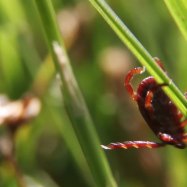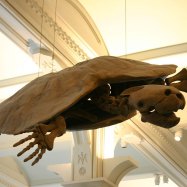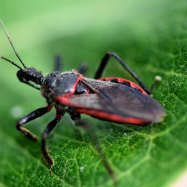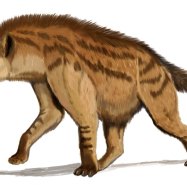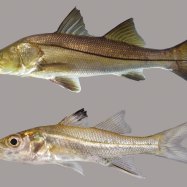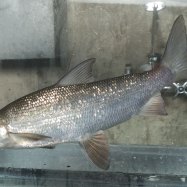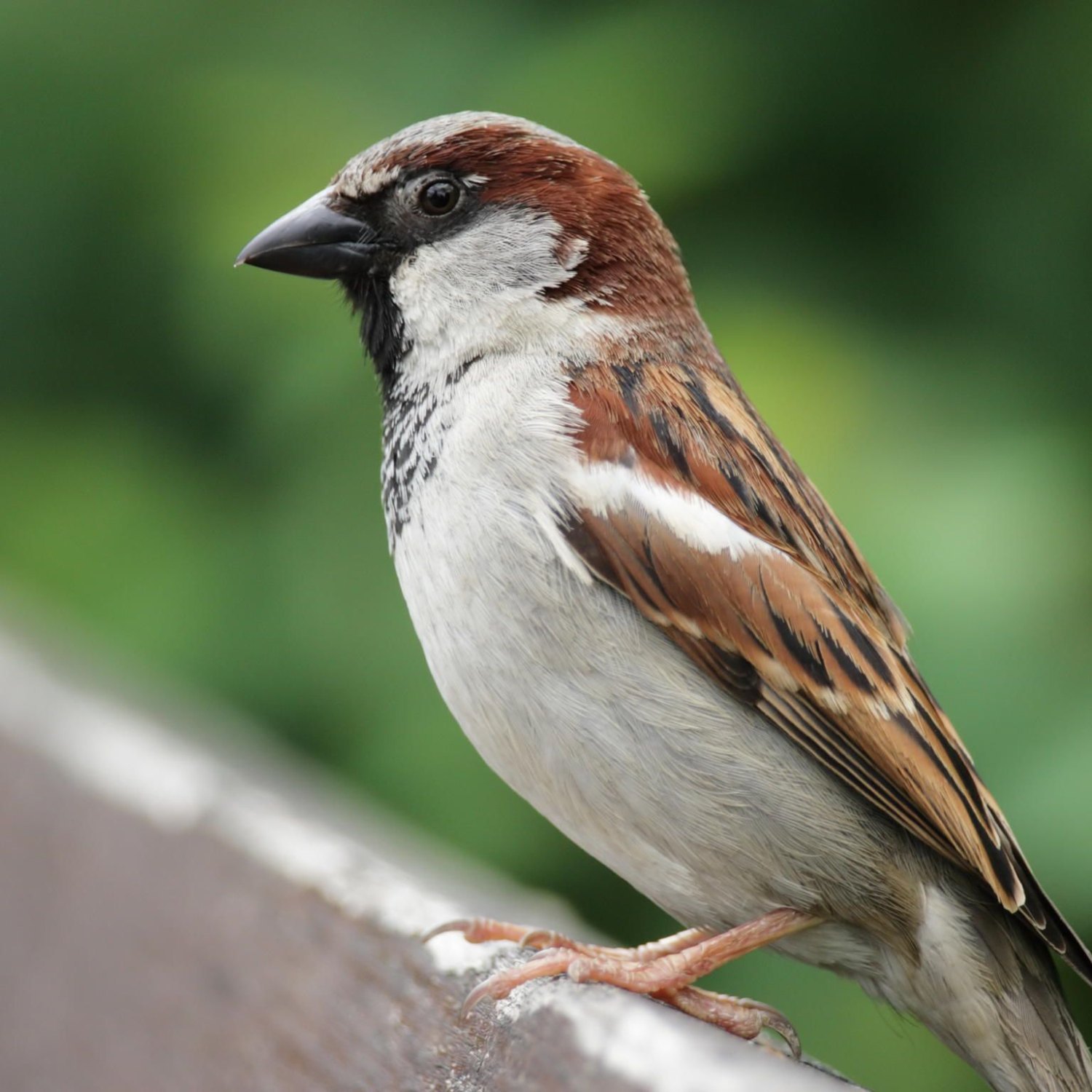
House Sparrow
14-16 cm
The energetic and social House Sparrow is a common sight in both urban and rural areas. With its small and compact body shape, this 14-16 cm bird belongs to the Passeridae family and is known for its distinctive chirping. Keep an eye out for this delightful creature in your neighborhood! #HouseSparrow #Passeridae #birdwatching
Animal Details Summary:
Common Name: House Sparrow
Kingdom: Animalia
Habitat: Urban areas, farmlands, open woodlands
The Endearing House Sparrow: A Common Sight in Urban and Rural Areas
With their cheery chirps and small yet sturdy bodies, house sparrows have become a familiar and beloved part of our urban and rural landscapes. You can spot them hopping and fluttering around in backyards, parks, and even city streets. But have you ever wondered about these small birds and how they have adapted so well to human habitats? Let's dive into the world of house sparrows and discover what makes them such fascinating creatures.The Genus and Species: Passer domesticus
The scientific name for the house sparrow is Passer domesticus, which literally translates to "sparrow of the house House Sparrow." This makes perfect sense considering that these birds are often found near human dwellings. They belong to the kingdom Animalia and phylum Chordata. Within the class Aves, they are categorized under the order Passeriformes, which includes perching birds like finches and warblers. Within this order, house sparrows belong to the family Passeridae.An Adaptation to Urbanization: Habitat and Distribution
One of the most interesting aspects of house sparrows is their ability to adapt to human environments. Traditionally, these birds were found in open woodlands and farmlands. However, with rapid urbanization, they have made a shift towards cities and towns. Today, house sparrows can be found in all continents of the world, except Antarctica. In fact, they have the widest geographical distribution of any bird species, with their origin in Europe, Asia, and North Africa Hare.In urban areas, house sparrows tend to thrive in areas where they can find food, water, and shelter. You can commonly find them nesting in buildings, under bridges, and even in car parks. They are also seen in suburban and rural areas, where they may feed on insects and grains in open fields and gardens.
An Omnivore's Diet
House sparrows are considered omnivorous, meaning they eat both plants and animals. Their diet changes depending on the season and availability of food. In the summer, they mostly feed on insects such as beetles, caterpillars, and spiders. During the winter, when insects are scarce, they switch to a more vegetarian diet, feasting on seeds, grains, and fruits.In urban areas, house sparrows have adapted to foraging for food scraps, often seen scavenging discarded food and crumbs from outdoor dining areas. They have also been known to eat garbage and bird feeders. This ability to adapt their diet has helped them thrive in human environments.
The Physical Characteristics of House Sparrows
The house sparrow is a small bird, measuring 14-16 cm in length. They have compact bodies with round heads and a short, square tail. The male and female differ slightly in appearance. The males have a brown and gray plumage, with a black bib on their throat. The females are mostly brown with less distinctive markings.One of the remarkable things about house sparrows is their adaptability to different climates and environments. This is reflected in their coloration, which can vary from region to region. For example, House sparrows in Africa have a paler coloration compared to their European and Asian counterparts. This difference in coloration is due to a process known as melanism, where darker pigments are produced to help them survive in hotter regions.
Your Friendly Neighborhood Sparrow
It's not hard to spot a house sparrow near you. With their small, cute appearance and melodic chirping, they quickly become the most endearing birds in any area. But did you know that house sparrows have a complex social structure? They form small communal groups, which may consist of monogamous pairs, their offspring, and yearlings. These groups are highly cohesive and work together to find food and protect their territories.Despite their communal living, house sparrows can also be quite territorial, especially during breeding season. They fiercely protect their nests and territory from other birds, often engaging in loud vocal and physical disputes. These territorial behaviors can sometimes be a nuisance in urban areas, leading to conflicts between house sparrows and other bird species.
A Climate-Proof Species
House sparrows are a tough and resilient species. They have endured harsh climates and human-induced changes to their habitats. In fact, their success in adapting to human environments has helped them increase in numbers. However, in recent years, there has been a decline in house sparrow populations in certain regions, especially in Europe and North America. This decline is thought to be due to factors such as increased pollution, use of pesticides, and habitat destruction.As humans, we have a responsibility to ensure the survival of these beloved birds. We can do this by creating habitat-friendly spaces, such as planting trees and shrubs and providing a clean water source. We must also be mindful of our actions, such as using eco-friendly products and reducing our use of pesticides, to help protect the house sparrow and other bird species.
A Part of Our Cultural and Historical Legacy
House sparrows have been an integral part of human history and culture. In many cultures, they are symbols of happiness, friendship, and good luck. They have also been featured in literature and art throughout history, from the ancient Egyptians to the modern-day.Moreover, in some parts of the world, house sparrows are considered a sacred animal. For example, in India, they are associated with the Hindu deity, Goddess Lakshmi, and are believed to bring prosperity and good fortune. In Japan, they are a symbol of family and home, and their image is often used in wedding invitations.
In Conclusion...
The house sparrow may seem like a small, common bird, but they are undoubtedly fascinating creatures. From their adaptability to urban environments to their endearing personality, there's no doubt that these birds have earned a special place in our hearts. By appreciating and protecting these birds, we can ensure that they remain a part of our lives for generations to come.

House Sparrow
Animal Details House Sparrow - Scientific Name: Passer domesticus
- Category: Animals H
- Scientific Name: Passer domesticus
- Common Name: House Sparrow
- Kingdom: Animalia
- Phylum: Chordata
- Class: Aves
- Order: Passeriformes
- Family: Passeridae
- Habitat: Urban areas, farmlands, open woodlands
- Feeding Method: Omnivorous
- Geographical Distribution: Worldwide
- Country of Origin: Europe, Asia, North Africa
- Location: Urban and rural areas
- Animal Coloration: Brown and gray
- Body Shape: Small and compact
- Length: 14-16 cm
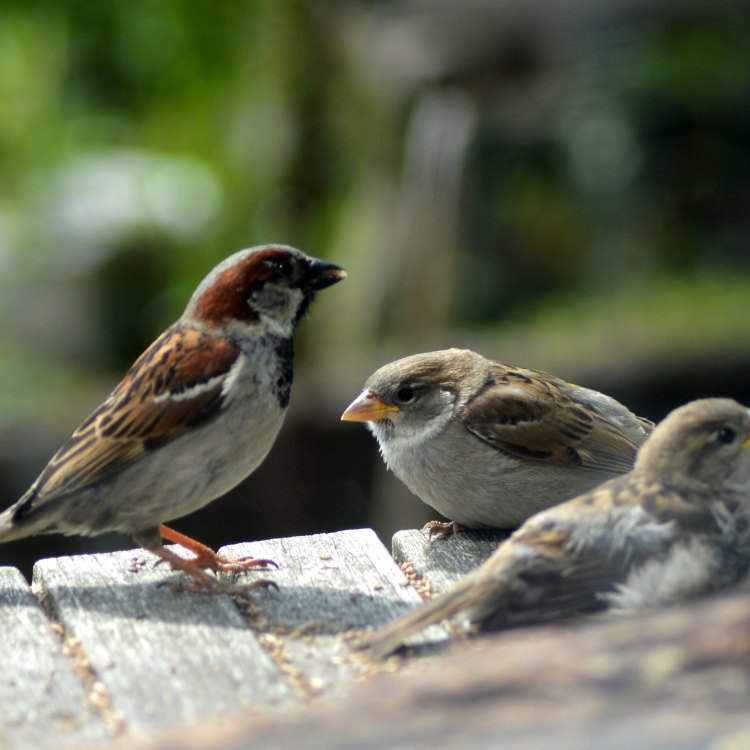
House Sparrow
- Adult Size: Adults weigh around 25-35 grams
- Average Lifespan: 3-5 years
- Reproduction: Sexual
- Reproductive Behavior: Monogamous, with males performing courtship displays
- Sound or Call: Chirping and trilling
- Migration Pattern: Most populations are resident, but some undertake short-distance migrations
- Social Groups: Form flocks during non-breeding season
- Behavior: Sociable and highly adaptable
- Threats: Loss of habitat, predation, diseases
- Conservation Status: Least Concern
- Impact on Ecosystem: Seed dispersal, insect control
- Human Use: Introduced to new areas as a biocontrol agent
- Distinctive Features: Small size, short tail, black bib on the throat
- Interesting Facts: Commonly found near human settlements and known for their chirping songs
- Predator: Birds of prey, domestic cats
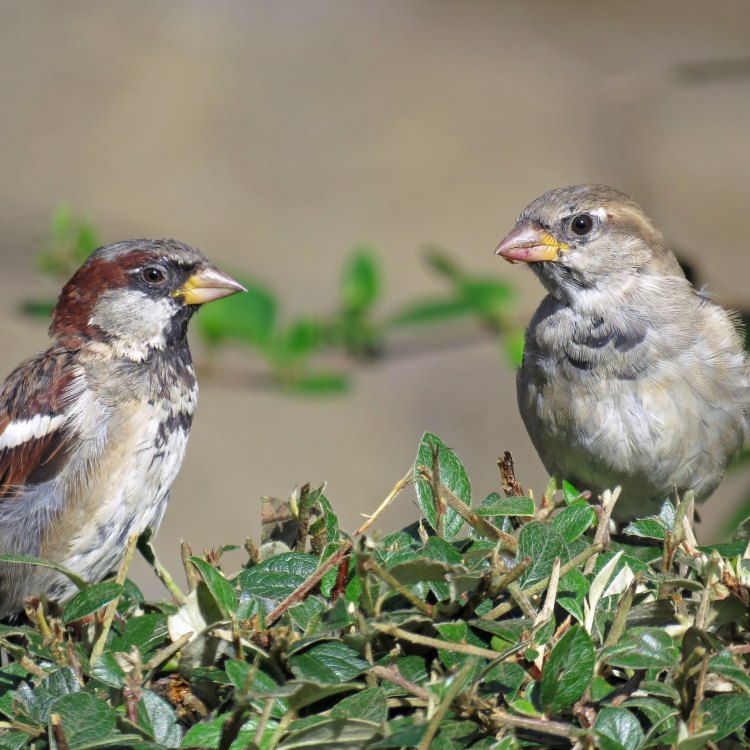
Passer domesticus
The Chirpy and Adaptable House Sparrow: An Unsung Hero of the Ecosystem
The house sparrow (Passer domesticus) is a small passerine bird that is often overlooked due to its common presence in urban and rural areas. However, this unassuming bird has a lot more to offer than just being a chirpy companion outside our windows. In fact, it plays a crucial role in the ecosystem and holds several interesting features that make it stand out among other avian species. Let's take a closer look at this feathered friend and discover why it deserves more recognition and appreciation PeaceOfAnimals.Com.A Look at the Basics: Size, Lifespan, and Reproduction
The house sparrow is a small bird, with an adult size averaging between 25-35 grams. It is mostly brown in color, with a grayish-brown back and a buff-colored belly. The male has a distinctive black bib on its throat, while the female has a plain brown throat. Its wingspan can range from 18 to 23 centimeters.On average, house sparrows have a lifespan of 3-5 years. However, in ideal conditions, they have been known to live up to 10 years. Their reproductive behavior is sexual, with males performing elaborate courtship displays to attract a mate. These displays include fluffing up their feathers, hopping, and making clicking noises.
During mating season, house sparrows are monogamous, meaning they form a pair with one mate for the entire breeding season Hepatic Tanager. This bond is only broken if one of the partners dies, and the surviving bird will then find a new partner. Once the female lays eggs, both parents take turns incubating them until they hatch.
From Chirping to Beguiling: Unraveling the Social and Behavioral Aspects
House sparrows are highly sociable birds and form flocks during the non-breeding season. These flocks can consist of over a hundred sparrows, and they often roost together at night. Within these flocks, there is a strict hierarchy determined by age, size, and strength. However, unlike other bird species, house sparrows do not have a clear leader or dominant individual.They are also highly adaptable birds, able to thrive in both rural and urban environments. In cities, they can often be found near human settlements, making use of the abundant food sources found in dumpsters and trash cans. In the countryside, they are often found nesting in hedges, shrubs, and other vegetation.
One of the most distinctive features of house sparrows is their sound or call. They are known for their chirping and trilling songs, which can often be heard in urban areas. The male sparrows even learn the songs of their neighbors and incorporate them into their own, creating a neighborhood song unique to each flock.
Challenges and Contributions: Threats and Impact on the Ecosystem
Like many other bird species, the house sparrow faces numerous threats, both natural and human-caused. Loss of habitat is one of the main challenges for these birds, as the destruction of hedges and other vegetation affects their nesting sites. Additionally, changes in agricultural practices have also led to a decline in insect populations, which are a vital food source for house sparrows.Predation is another issue that house sparrows face. They are often targeted by birds of prey such as hawks and owls, as well as domestic cats. In areas where house sparrows are introduced, they can also face competition and predation from non-native bird species.
Despite these challenges, house sparrows play an essential role in the ecosystem. As seed dispersers, they help to maintain plant diversity, and as insect-eaters, they contribute to controlling insect populations. In fact, studies have shown that areas with higher house sparrow populations have lower insect pest populations, making them a natural form of pest control.
Human Utilization and Conservation Status
While house sparrows may not be considered as a popular pet or a source of food for humans, they have been utilized in other ways. In the mid-19th century, house sparrows were introduced to North America as a biocontrol agent to combat an infestation of insect pests in crops. However, they have since become an invasive species and have had a negative impact on the native bird species in the region.In many parts of Europe and the United States, house sparrows are also used as an indicator species for air pollution. Due to their close proximity to human settlements and high sensitivity to air pollution, changes in their populations can indicate levels of pollution in the area.
As for their conservation status, the house sparrow is listed as "Least Concern" on the IUCN Red List. While their populations have declined in certain regions, they are still widespread and abundant in most areas. However, ongoing monitoring and conservation efforts are still vital to ensure their numbers do not decline further.
In Conclusion: An Unsung Hero of the Ecosystem
In conclusion, the house sparrow may be small in size, but it holds a significant role in the ecosystem. With its sociable and adaptable nature, unique courtship displays, and distinctive songs, it is a fascinating bird to observe and appreciate. However, it also faces various threats, including habitat loss and predation, which highlights the need for conservation efforts.As humans, we have a responsibility to conserve and protect not only iconic and endangered species but also the lesser-known and underappreciated species like the house sparrow. By understanding their importance and the challenges they face, we can work towards creating a more sustainable and harmonious environment for all species to thrive. So, the next time you hear the chirping and trilling of a sparrow, take a moment to appreciate this unsung hero of the ecosystem.
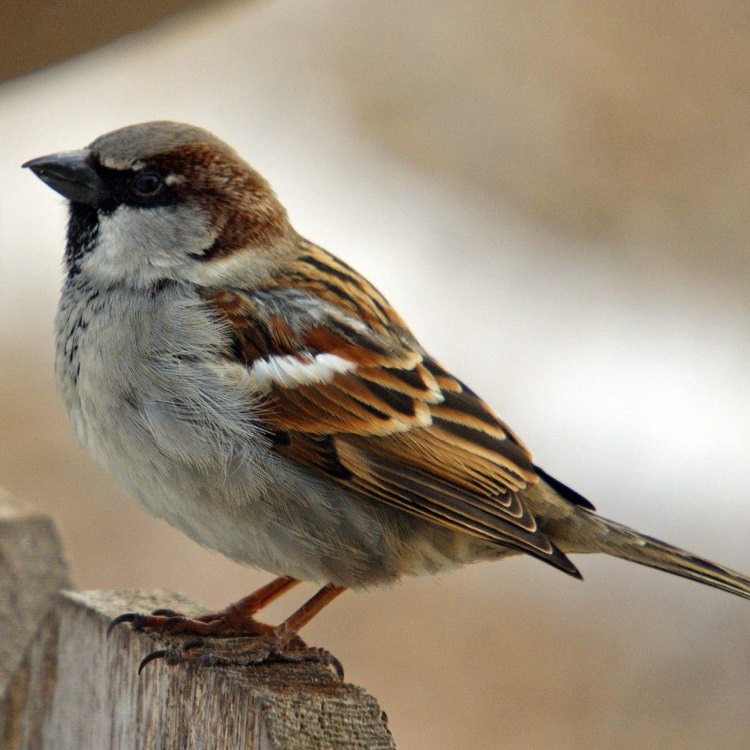
The Endearing House Sparrow: A Common Sight in Urban and Rural Areas
Disclaimer: The content provided is for informational purposes only. We cannot guarantee the accuracy of the information on this page 100%. All information provided here may change without prior notice.

